The Basics of Poker

Poker is a card game where players attempt to form the best hand possible. It is played from a standard pack of 52 cards, and some variants use more than one deck or add extra cards called jokers.
To play poker, you have to ante something (usually a small amount, like $1 or $5), and the dealer will deal two cards to each player. Then, when it’s time to bet, you can choose to fold, call, or raise.
There are a lot of strategies and tactics involved in playing poker, but the most important thing to remember is to have fun. You can’t win a large amount of money from poker unless you enjoy it. Besides, if you don’t have fun, you won’t last very long at the tables.
The basic strategy for poker is to bet a reasonable amount, and then try to force the other players to fold their weaker hands. This is known as bluffing, and it is one of the most popular strategies in the game.
When betting, you can choose to bet a small amount (called calling), or a large amount (called raising). If you call, you’ll get your bet back in the pot; if you raise, you’ll add more money to the pot and increase your chances of winning the pot.
You can also bet aggressively when you have a premium hand, such as a pair of Kings or Queens or an Ace-King or Ace-Queen combination. If you do this, you’ll make other players think twice about going head-to-head with you.
Another good strategy is to bet a little bit aggressively with a weaker hand, such as an unconnected pair of low-ranking cards or a pocket pair that contains an ace on the flop. This is a good way to keep yourself out of trouble and ensure that other players will have to pay to see your hand.
Stack sizes are another key factor in poker. Generally, a shorter-stacked player should play more hands with high card strength, and a longer-stacked player should play fewer speculative hands and be more aggressive.
A poker player can also try to deceive their opponents by playing slowly, and letting the other players lead before they commit their own stacks to the pot. This is often done in situations where a strong hand is on a rainbow, uncoordinated board, and the other player has a weaker, “made” hand.
In this case, a slow player would check or bet weakly, then hesitate for a while and make an oddly large bet to appear like they’re stealing the pot.
The sizing of your bet can tell you a lot about how savvy you are at reading the other players, and this is an essential skill to master in poker. You can do this by looking at how often the other players bet and fold, as well as their sizing.
When you’re a novice at poker, you need to practice the basics first before moving on to more advanced concepts. The more you practice, the easier it will be to understand the ins and outs of the game.